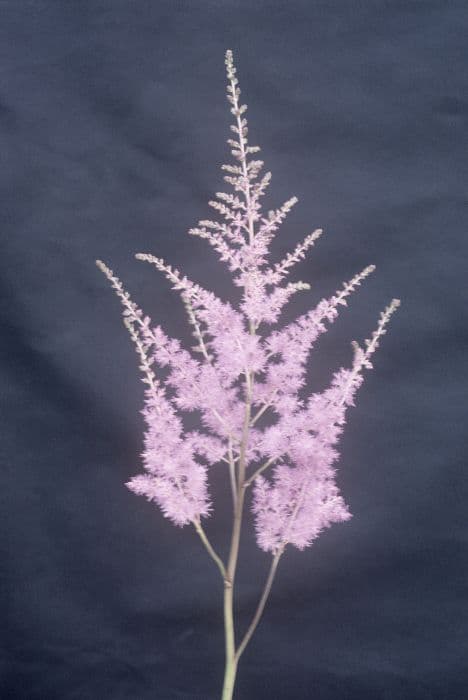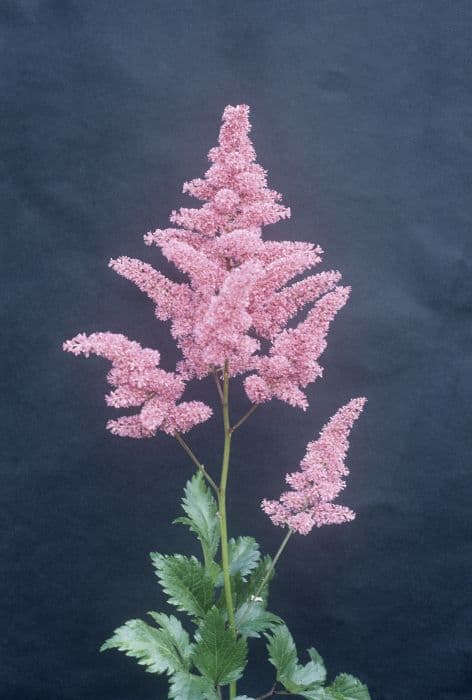Dwarf Chinese Astilbe Astilbe chinensis var. pumila

ABOUT
Astilbe chinensis var. pumila, commonly referred to as Dwarf Chinese Astilbe, is a compact, clump-forming perennial that boasts attractive features making it a popular choice for gardens. This dwarf variety exhibits a bushy mound of deep green, fern-like foliage that is intricately cut, lending a fine-textured appearance to the garden. The leaves are typically glossy and can be somewhat coarse to touch. During the blooming season, Dwarf Chinese Astilbe produces pyramidal plumes that are densely packed with tiny, star-like flowers. These blossoms are typically a soft to deep mauve-pink color, creating a frothy, feathery look that adds a soft contrast to the coarser foliage below. The flowers are held on stiff stems that rise above the foliage, forming a visually pleasing canopy of color. These blossoms are known for their ability to add a light, airy feel to the planting area and are often visited by butterflies and other pollinators. After the flowers have finished blooming, they may turn to a tan or brown color, providing continued interest and texture in the garden. The plants can create a visually lush groundcover with their foliage and flowers, making Dwarf Chinese Astilbe a favorite for mass plantings, borders, and woodland gardens due to their attractive appearance throughout the growing season.
About this plant
 Names
NamesFamily
Saxifragaceae.
Synonyms
Dwarf Chinese Astilbe, Chinese Astilbe, Dwarf False Goat's Beard, Pumila Astilbe, Dwarf Astilbe.
Common names
Astilbe pumila, Astilbe chinensis var. taquetii, Astilbe pumila var. taquetii, Astilbe chinensis f. pumila, Astilbe chinensis subvar. pumila, Astilbe chinensis var. tomentosa.
 Toxicity
ToxicityTo humans
Dwarf Chinese Astilbe is generally considered non-toxic to humans. There are no well-documented cases of poisoning, and it is not known to have any toxic properties that would lead to adverse health effects upon ingestion. Even though it's not toxic, it is not meant for consumption, and eating any plant material might cause discomfort or an unintended reaction in some individuals.
To pets
Dwarf Chinese Astilbe is also generally considered non-toxic to pets. It should not cause any serious symptoms of poisoning in animals such as dogs and cats if they ingest parts of the plant. However, as with any non-food plant, ingestion could potentially lead to mild gastrointestinal upset, so it is always prudent to discourage your pets from eating ornamental plants.
 Characteristics
CharacteristicsLife cycle
Perennials
Foliage type
Deciduous
Color of leaves
Green
Flower color
Lavender
Height
1 foot (30 cm)
Spread
1 foot (30 cm)
Plant type
Herb
Hardiness zones
4
Native area
Asia
Benefits
 General Benefits
General Benefits- Low Maintenance - Astilbe chinensis var. pumila is relatively easy to care for, requiring minimal upkeep once established.
- Drought Tolerance - Although it prefers moist conditions, it can tolerate periods of drought.
- Shade Tolerance - This plant thrives in partial to full shade, making it a versatile choice for many garden settings.
- Attracts Pollinators - The flowers of the plant attract butterflies and bees, promoting pollination in the garden.
- Deer Resistant - Astilbe chinensis var. pumila is generally resistant to deer, reducing the risk of damage from browsing animals.
- Ground Cover - With its compact habit, it acts as a ground cover, helping to suppress weeds and protect the soil.
- Seasonal Interest - The plant provides seasonal interest with its plumes of flowers in the summer and its foliage in the fall.
- Erosion Control - Its root system can help stabilize soil and control erosion on slopes or in areas prone to soil loss.
- Visual Appeal - The feathery plumes of flowers and fern-like foliage add texture and visual interest to any garden.
- Border Planting - The compact size makes this variety particularly well-suited for borders or edging in garden designs.
- Variety of Colors - It offers a variety of bloom colors, which can complement many color schemes in a landscape.
- Easy to Propagate - The plant can be easily propagated by division, allowing gardeners to spread its beauty to other parts of their gardens.
 Medical Properties
Medical PropertiesThis plant is not used for medical purposes.
 Air-purifying Qualities
Air-purifying QualitiesThis plant is not specifically known for air purifying qualities.
 Other Uses
Other Uses- Astilbe chinensis var. pumila, commonly known as Dwarf Chinese Astilbe, can be used in flower arranging due to its feathery plumes, adding texture to bouquets.
- Dwarf Chinese Astilbe can be planted to prevent soil erosion on slopes because its dense root system holds the soil in place effectively.
- The plant is great for butterfly gardens; it attracts butterflies, providing an ideal habitat for these pollinators.
- Dwarf Chinese Astilbe can serve as a living mulch, as its foliage provides ground cover that helps retain soil moisture and suppress weed growth.
- These plants are also used to signal the health of an ecosystem; their presence often indicates a well-balanced soil moisture level.
- The contrasting texture and color of Dwarf Chinese Astilbe can be utilized in photography for nature-inspired backdrops or creative macro shots.
- In education, Dwarf Chinese Astilbe can be used as a model plant to study plant biology and ecology in temperate climates.
- The plant can be used in sensory gardens for its unique feathery flower texture, which can be interesting to touch.
- Dwarf Chinese Astilbe's dense clumps offer small animals like frogs and toads a cool, moist shelter, especially during hot days.
- This variety of astilbe can be used in ecological landscape design as a method to balance human-made elements with natural flora to create aesthetically pleasing environments.
Interesting Facts
 Feng Shui
Feng ShuiThe Chinese Astilbe is not used in Feng Shui practice.
 Zodiac Sign Compitability
Zodiac Sign CompitabilityThe Chinese Astilbe is not used in astrology practice.
 Plant Symbolism
Plant Symbolism- Patience: Astilbe takes time to bloom and requires careful tending and patience, making it symbolic of the virtue of patience in human life.
- Devotion: With its dense clusters of flowers, Astilbe often represents dedication and a depth of feeling, evoking the sense of loyalty and commitment.
- Endurance: As a hardy perennial that returns reliably every year, it conveys an ability to withstand difficult conditions and persevere.
- Hope: Its lush and feathery plumes can symbolize hope, as they brighten shaded garden spaces with their presence.
- Delicate Beauty: The fine and feathery texture of the Astilbe's flowers is often associated with a gentle and delicate form of beauty.
 Water
WaterDwarf Chinese Astilbe prefers consistently moist soil, so water thoroughly whenever the top inch of soil feels dry. Usually, this means watering deeply once or twice a week, depending on climate conditions. Provide about one to two gallons of water per week during the growing season, cutting back during fall as the plant prepares for dormancy.
 Light
LightDwarf Chinese Astilbe thrives best in partial to full shade, especially in areas with hot summers. Protect it from harsh afternoon sun, which can scorch the leaves. A spot that gets morning sun and afternoon shade is ideal for this plant.
 Temperature
TemperatureDwarf Chinese Astilbe grows best in temperatures between 60 and 75 degrees Fahrenheit but can survive within a range from 40 to 85 degrees Fahrenheit. It is a hardy plant that can tolerate the cold well once established, but excessive heat can stress the plant, especially if it's in direct sunlight.
 Pruning
PruningPrune Dwarf Chinese Astilbe mainly to remove spent flower stalks and encourage reblooming. Deadheading, which can be done throughout the blooming period, will tidy up the plant and can sometimes stimulate a second wave of flowers. After the first hard frost in fall, cut back the foliage to the ground to keep your Astilbe healthy and prepare it for the next growing season.
 Cleaning
CleaningAs needed
 Soil
SoilDwarf Chinese Astilbe prefers a soil mix that is rich in organic matter, well-draining yet moisture-retentive. An ideal mix could consist of two parts garden soil, one part peat moss, and one part perlite or coarse sand to improve drainage. The soil pH should be acidic to neutral, around 6.0 to 7.0, to support its growth.
 Repotting
RepottingDwarf Chinese Astilbe does not require frequent repotting and can thrive in the same pot for several years. It typically needs repotting every 3 to 4 years, or when it outgrows its current container or the soil is exhausted.
 Humidity & Misting
Humidity & MistingDwarf Chinese Astilbe thrives in high humidity environments. The best humidity level for this plant is around 60% to 80%, mimicking its natural lush, woodland habitat.
 Suitable locations
Suitable locationsIndoor
Place Dwarf Chinese Astilbe in shade and keep soil consistently moist.
Outdoor
Use rich soil, partial shade, and keep ground moist for Dwarf Chinese Astilbe.
Hardiness zone
4-8 USDA
 Life cycle
Life cycleAstilbe chinensis var. pumila, commonly known as Dwarf Chinese Astilbe, begins its life cycle when its seeds germinate in moist, fertile soil in late spring. The seedlings develop into clumps of fern-like foliage, and as the plant matures, it forms a dense mound of greenery. During early to mid-summer, Dwarf Chinese Astilbe produces small, plume-like, pink to lavender flowers on stiff stems that rise above the foliage. After flowering, the plant sets seeds which can disperse into the surrounding area, potentially giving rise to new plants the following season. In late autumn, the foliage dies back as the plant enters dormancy to survive the winter. With the return of warmer temperatures and spring conditions, the plant will emerge from dormancy to start its cycle anew.
 Propogation
PropogationPropogation time
Late spring to early summer
Astilbe chinensis var. pumila, commonly known as Dwarf Chinese Astilbe, is most effectively propagated by division. The best time for this is in early spring or autumn when the plant is not in active growth. To propagate by division, carefully dig up the plant, ensuring you get as much of the root system as possible. Gently tease the plant apart into smaller clumps, each with several growing points. These divisions can be immediately replanted in well-prepared soil, spaced about 12 to 15 inches (approximately 30 to 38 centimeters) apart to allow for growth. Water the new divisions thoroughly to help establish them. This method not only propagates the plants but also invigorates older clumps that may have become woody and less floriferous over time.









